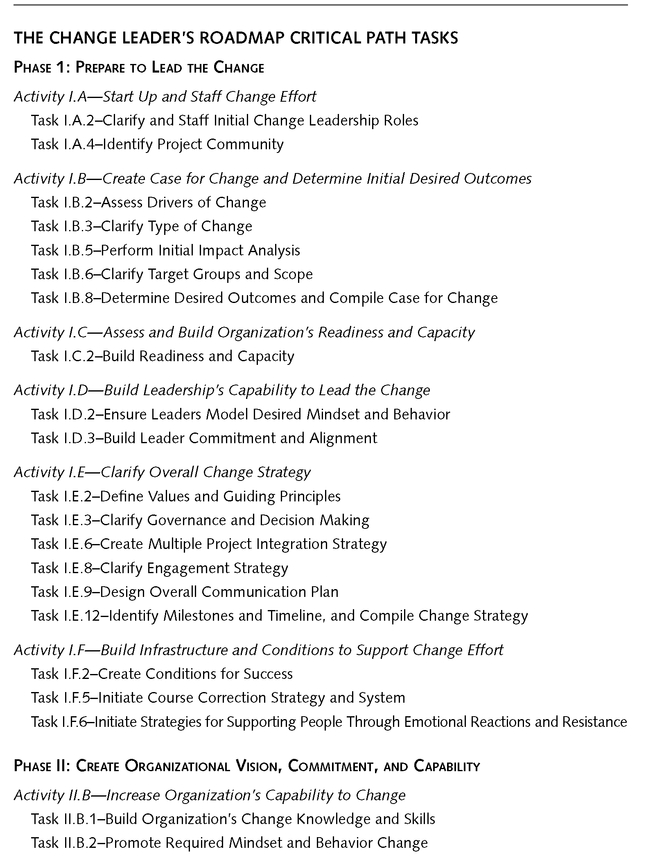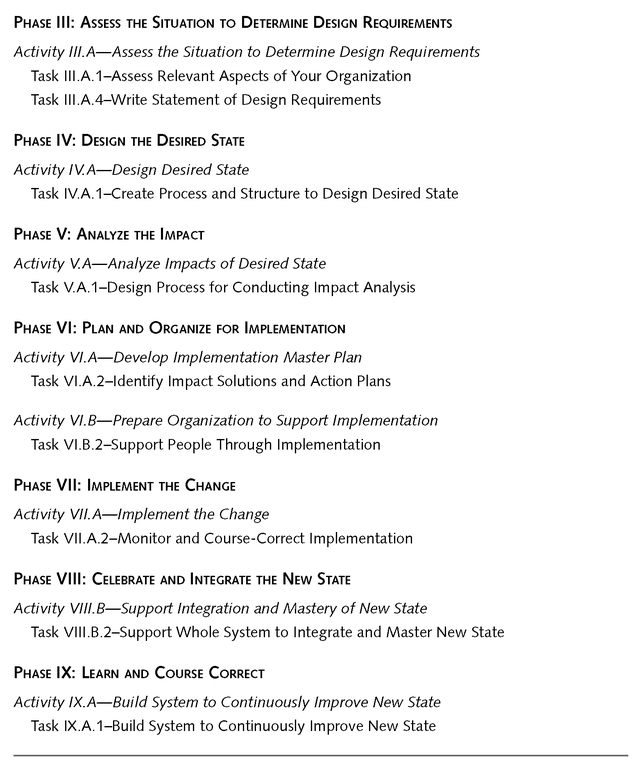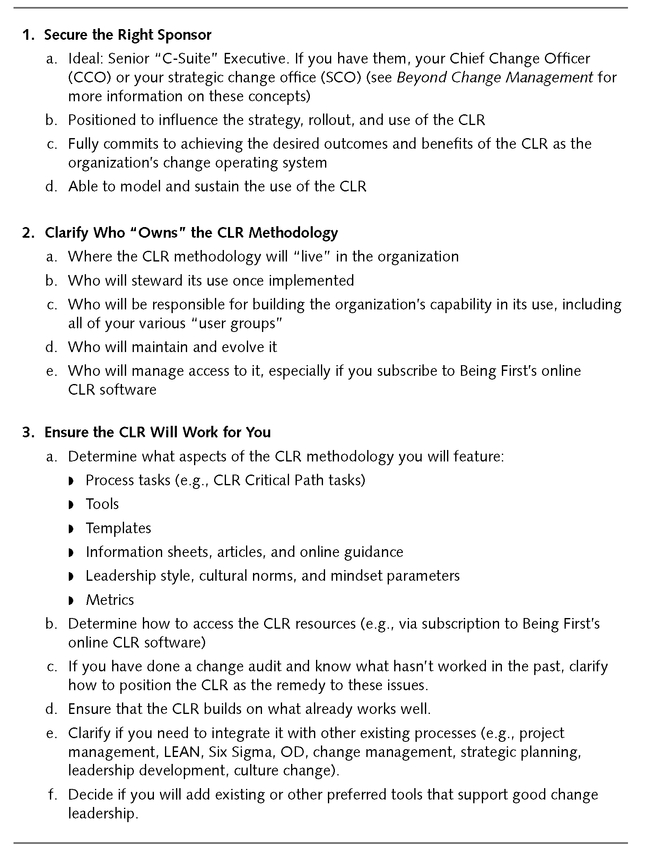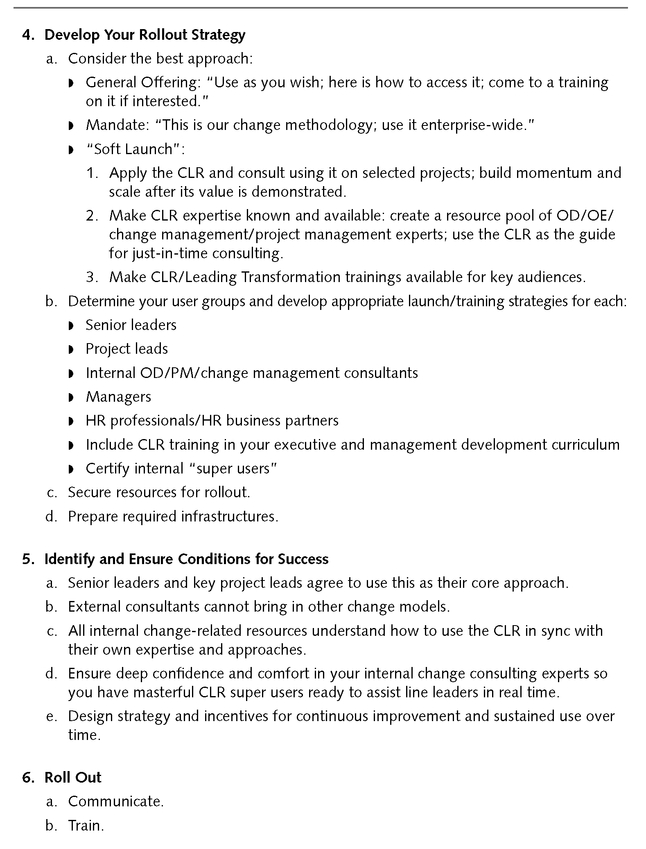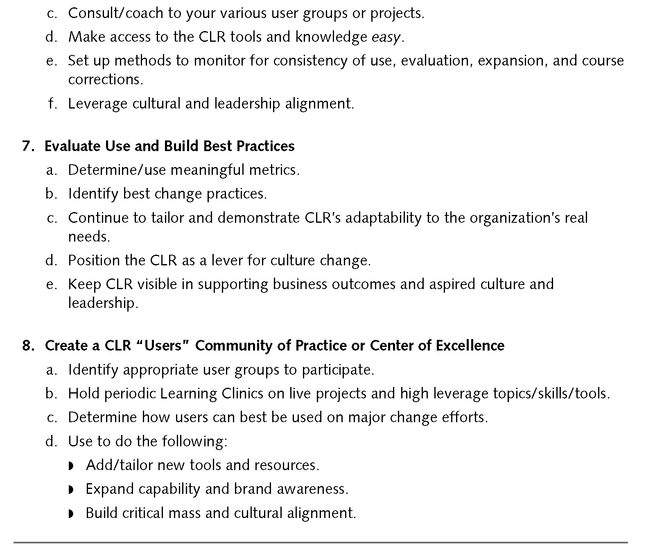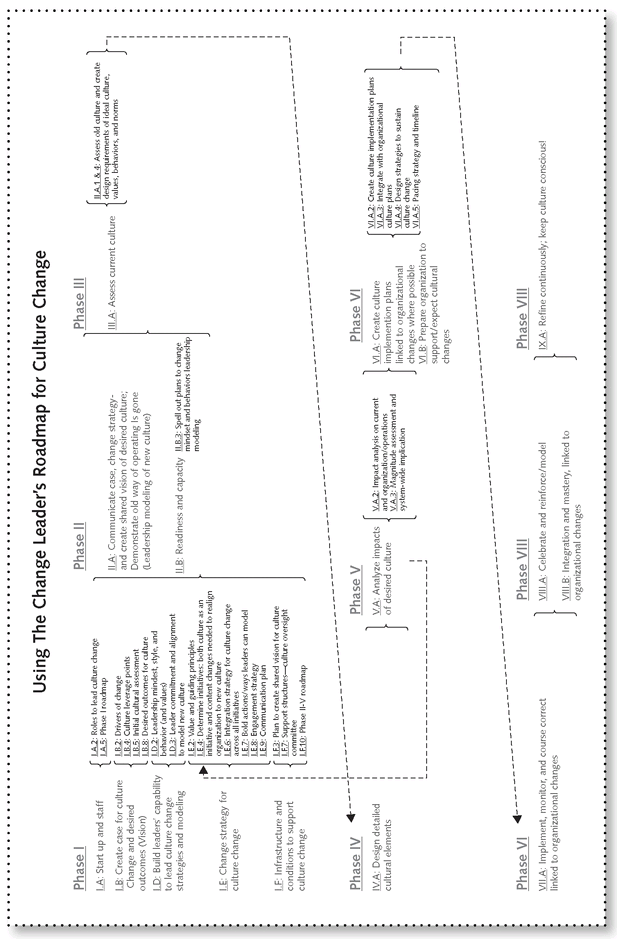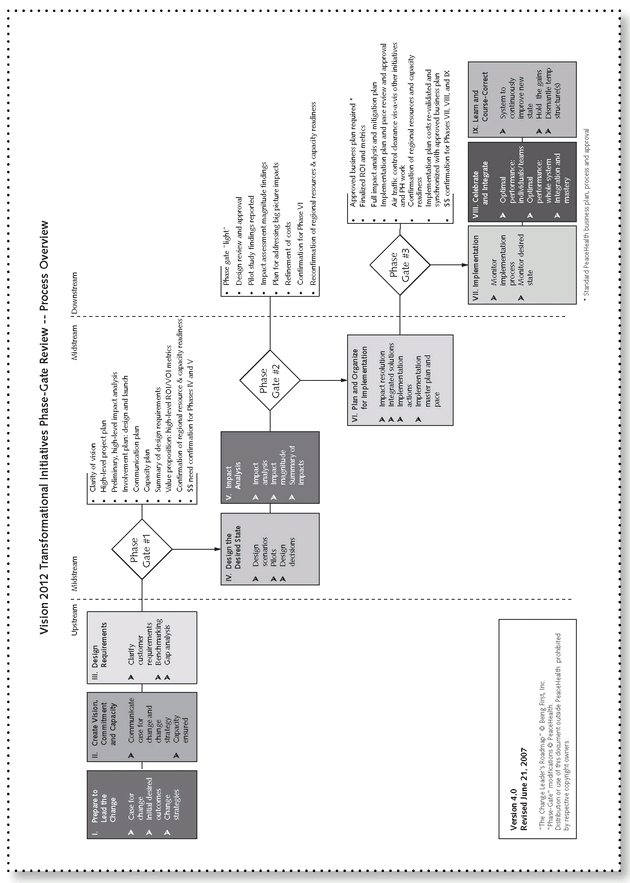CHAPTER 14
Opportunities for Leveraging The Change Leader’s Roadmap Methodology
After you decide to use The Change Leader’s Roadmap methodology, you must decide how to gain the greatest value from it. We recommend several ways to use and leverage the unique attributes of the CLR methodology:
1. Apply the CLR Critical Path, which consists of the thirty most important tasks in the methodology, to streamline your project planning process.
2. Use The Change Leader’s Roadmap as your organization’s common change methodology on all change initiatives.
3. Increase your organization’s change capability.
4. Use the CLR to transform your organization’s culture.
5. Use the CLR as a “just-in-time” consulting strategy.
6. Find ways to accelerate the change process.
7. Use the CLR as a phase gate process.
We will first look at the best way to begin your project planning process on each change effort you lead.
THE CLR CRITICAL PATH
After you become fully versant in the CLR methodology, you will be able to decipher which of the seventy-seven tasks to do on each new change effort you lead or support. To expedite your learning and planning, we have identified the CLR Critical Path. The CLR Critical Path consists of the thirty most important tasks in the methodology. We selected the tasks based on our thirty years of experience observing the work most critical to client success. This does not mean that you must always do the thirty tasks in every change effort. It means that being familiar with this list can help you more quickly determine which tasks you might select as your starting place. Review the list in
Exhibit 14.1 to understand why these tasks are on the list. Always keep in mind that other tasks in the CLR might also be required work for any of your change efforts.
In the Introduction, we mentioned the strategy to use the CLR as your organization’s common change methodology. After your key change leaders and consultants have learned about the methodology and how to tailor it, this strategy can greatly reduce time, confusion, and the cost of change across the organization.
USING THE CHANGE LEADER’S ROADMAP AS YOUR COMMON CHANGE METHODOLOGY
At any point, most organizations have many change efforts underway. These initiatives may or may not appear to be related or integrated. In fact, most often, they compete with each other for time, attention, and resources. Almost all are run using different and inconsistent methods, producing confusion in the organization and slowing down progress and results. No wonder the workforce resents the “flavor of the month” syndrome and loses faith in leadership’s ability to lead change! Imagine if your leaders all used different accounting methods, performance management systems, or compensation formulas!
The most value-added application of the CLR is using it as your common change methodology, the operating system for how all existing and future change efforts are led. Much like Microsoft’s Windows™, or the MAC-OS™ systems that support the consistent running and cross-referencing of myriad software programs, using The Change Leader’s Roadmap as the operating system for all change initiatives ensures that they all run in a manner that promotes integration across business content, people, and process issues. Without a common way of leading, your various initiatives cannot be integrated to serve the overall good of the organization. Having a common change methodology provides great leverage for monitoring how major changes are being planned and led. It enables projects to share work products, integrate tasks, and share resources. Having shared language, strategies, and tools greatly expedites your oversight and review process. See Beyond Change Management for a complete discussion.
Who needs to use your common change methodology? In today’s fast-paced, ever-changing world, influencing the success of change is inevitably the job of every line leader in your organization. Your executives will need a high-level understanding, as will all of your sponsors of change. Your line leaders—in position to champion your organization’s major changes—ought to have at least a conceptual understanding of The Change Leader’s Roadmap as a required process methodology and navigation system. Your in-house consultants would, of course, be trained in it in greater depth to consult, accelerate, and enable effective change leadership, but line leaders must ultimately be accountable for producing results from their change efforts. All project leads and project management experts must be familiar with the CLR at a minimum, and optimally, know how their tools and approaches fit against it.
If you decide to implement the CLR as your change operating system, be aware that there is a serious risk in asking an already overloaded organization to learn a new methodology for leading change. The initiative leaders may view the methodology as yet another change program, something to be added on top of all of the other change initiatives underway. In fact, The Change Leader’s Roadmap is not something else to be done on top of existing efforts and must not be positioned that way. Instead, it should support the way in which you are setting up and accomplishing all existing efforts. Of course, learning the change methodology does take additional time on the part of change leaders and consultants who will apply it. If they recognize in advance, however, that the organization is serious about improving its change leadership track record, then this learning needs to take place. Let’s explore the benefits of a common change methodology and a case example.
The benefits of having a common change methodology include the following:
• Increases speed in project launch, design, and implementation
• Sets a standard for best change practices
• Reduces resistance and confusion
• Establishes a common expectation for change governance, including clear roles, decision making, and temporary structures, systems, policies, and technologies
• Builds protocol for quickly establishing conditions for success that expedite planning, design, and implementation
• Makes integration of change efforts and information sharing across initiatives easier for acceleration and course correction
• Consistently and effectively handles the human dynamics of change
• Creates common language for effective change communications and stakeholder engagement
CASE-IN-POINT
We worked with one organization that had more than thirty “priority” change efforts underway simultaneously. People were exhausted and frustrated with their leaders. The executives engaged us to help organize, prioritize, and coordinate their many initiatives into one unified approach and build the organization’s understanding of its transformation.
Consistency and integration of the discrete efforts were desperately needed because many of the initiatives were competing with each other when their outcomes could only be achieved through working synergistically together. Nearly every initiative was being run using a different change model, if one could even be deciphered. This made collaboration nearly impossible. Like different computer platforms, the initiatives could not “talk” to each other. They needed a common language and approach.
We established, with the backing of the CEO, that one change methodology would be used in the organization. We helped the change leaders prioritize their top initiatives and educated them and their internal consultants in The Change Leader’s Roadmap. The training was all “live case-based,” and the change leaders applied the model to each of their top initiatives as they learned it. Those that had used different change models were supported to map their work to the CLR to make the transition to it easier. Having a change process operating system became a strategic advantage that provided a basis for consistency, integration, and flexibility. With this approach, their multiple changes could coexist, work in collaboration, and be communicated as one overarching transformation. The methodology allowed them to lead all of the changes in a coherent yet customized fashion. With continuous follow-up, application clinics and coaching, the leaders learned and established a system that met the majority of their needs as well as accomplishing their transformation.
• Enables better progress monitoring using similar criteria and process milestones
• Accelerates start-up of change teams, and eases shifting change team members to other change projects as needed
• Reduces resource needs
• Enables better management of capacity and understanding of the impact on operations
Should you decide to use The Change Leader’s Roadmap as your common approach to change, consider the guidance in
Exhibit 14.2, Strategies to Implement the CLR as Your Common Change Methodology.
Increasing the Organization’s Change Capability

Conscious change leaders embrace building change capability as an outcome of their work. Strong change capability is vital to their organizations’ near- and long-term success. Defined simply, change capability is the ability of an organization to plan, design, and implement all types of change efficiently with committed stakeholders, causing minimal negative impacts on people and operations so that desired business and cultural results from change are consistently achieved and integrated seamlessly into operations to deliver maximum ROI. A key strategy for doing this is to view change as a strategic discipline, much like we view finance, HR, IT, and supply chain. This means not only building your leaders’, managers’, and internal consultants’ change leadership knowledge and skills but also the organizational systems and infrastructure that will enable change to be led more effectively and consistently.
Beyond Change Management discusses change capability and the strategic disciplines for change in more detail, but here is an overview. (See Premium Content: Building Change Capability: Leading Change as a Strategic Discipline,
www.pfeiffer.com/go/anderson.)
We have identified five key strategies so far to creating change as a strategic discipline: (1) identifying and managing an enterprise change agenda; (2) having one common change process methodology—ideally the CLR; (3) establishing a change infrastructure; (4) building a strategic change center of excellence for all change practitioners, and (5) creating a strategic change office.
An enterprise change agenda names the most important change initiatives required to execute your organization’s business strategy. Its purpose is to capture and integrate the major changes underway or planned in your organization, ensuring their strategic relevance to business success. We have already discussed the benefits of using the CLR as your common change methodology. It can also be used to guide your creation of organizational change capability. Change infrastructures support your organization to deliver results from change by establishing and using overt, commonly used structures and practices that optimize change execution, accelerate time to results, and build capacity. Once established, these infrastructures become the baseline for people to increase their change leadership effectiveness. They provide a foundation for ensuring your organization’s change capability.
Exhibit 14.2. Strategies to Implement the CLR as Your Common Change Methodology
A Strategic Change Center of Excellence is comprised of the organization’s major change support resources, such as project management, change management, and quality improvement. Likely, your organization has all of this consulting expertise in place at its headquarters and in its business lines. The Center is a way of organizing, networking, and training them for the best and highest use. It need not house all of these resources; rather, it is a function and service that supports them, accesses them for priority change efforts, and develops them as a unified pool of resources.
The strategic change office (SCO) is a senior executive function that oversees the success of change across the entire enterprise. It is led by the Chief Change Officer (CCO), who sits on the executive team. This enables the SCO to be positioned to ensure that major change initiatives are the right ones to drive the business strategy, advocating for what is needed to maximize results on these mission-critical initiatives, and ensuring strong change capability in the organization. The SCO is the primary vehicle for making change a strategic discipline, including the effective use of the CLR to support the success of change overall.
Using the CLR to Change Your Organization’s Culture
Culture change is one of our core specialties. In Beyond Change Management, we describe seven key strategies for culture change, called the Being First Approach to Transforming Culture. We customize these strategies and their application to each client’s needs and use the CLR to guide their implementation. This organizes the work and ensures that all vital tasks get attention.
Although the entire CLR supports culture change, various tasks specifically drive this work. Throughout this book, we have referenced special guidelines in these tasks to use when you are transforming your organization’s culture.
Figure 14.1 shows the nine phases of the CLR as a flow chart that calls out these tasks in terms of the work required for culture change. If you are working to change culture, study this flow chart, as well as the seven strategies offered in
Beyond Change Management.
Culture permeates everything in the organization: your structure, systems, business processes, and technology, as well as individual, team, and organizational behavior. Each needs to be addressed as a part of transforming your culture. Similarly, consciously design and implement your organization’s content initiatives to reflect your desired culture, not your current culture, as they will inevitably affect your cultural outcomes. You will need to establish a legitimate role on these initiatives to be the spokesperson—and integrator—for the organization’s overall culture change.
The CLR makes a strong case that individual mindset and behavior are foundational to the organization’s collective culture. We strongly recommend that you provide some form of Leadership Breakthrough Training to shift mindset and behavior so that it overtly aligns with and supports your desired culture. See Tasks I.D.2 and II.B.2 for further guidance on this work.
The CLR Just-in-Time Consulting Strategy
The CLR just-in-time consulting strategy is an approach for using the Roadmap to serve fast-paced organizations that would otherwise never reap its benefits, although they urgently need them. Often, the leaders of these organizations do not understand the complexities of transformation and unknowingly make critical assumptions about how to lead change that end up being costly to their results and people. The CLR just-in-time strategy can help raise these leaders’ awareness in small, value-added doses and relatively painless ways. This is also a viable strategy for use when leaders are not interested in building their own change leadership capability but rather want focused and expert help from consultants. What follows is a composite of recommendations that can assist these leaders to succeed in change.
The CLR just-in-time strategy can be used when companies recognize that they (1) don’t have management’s time or interest to stop, learn, and master a methodology; (2) need better change leadership and greater results from their change efforts; (3) are undergoing large-scale change; and (4) have a cadre of in-house change consultants who can learn the CLR as their common change methodology and be used to support this effort. This strategy goes deep with the few, typically proficient change consultants who can be trained to offer competent advice to line leaders on an as-needed basis.
There are three required steps in this strategy. A fourth, when done upfront, can help the organization master its transformation exponentially. However, not all organizations as yet are willing to take on the upfront work. We will discuss it last. The three steps that must be done are (1) adoption of the CLR as the organization’s common change methodology; (2) in-depth CLR training of the in-house consultants who will serve as the source of its use in real-time application; and (3) line leader use of these trained resources on live projects, starting at the onset of change.
To begin this strategy, you must make the decision to use the CLR as your change operating system. This can be done in the OD department if they “own” change; in the change management function; in HR; in a Project, Program, or Portfolio Management Office; or by the executives who recognize that a consistent best-practice approach is required to improve their track record in change.
Next, you must select the people who will be trained in the CLR methodology in depth. Ideally, you will select a majority of senior practitioners who have tangible experience in the people, process, and perhaps even the needed content elements of the changes they will support. We highlight the selection of at least a majority of senior practitioners because junior consultants will realistically spend more time learning than delivering sound change advice. They can, however, be mentored by the proficient practitioners as they work.
This team becomes the organization’s primary “change agent” resource team. These consultants would be in charge of mastering, owning, and customizing the CLR methodology to best serve the initiatives the organization is undertaking. External CLR master consultants can support the team’s learning process and work. With skill in the CLR, the consultants can better support the needs of their line leader clients, demonstrate the value of the CLR guidance in real time, and educate the rest of the organization when appropriate.
The key to this group’s success is that they be used by change leaders on live efforts, beginning ideally at the start-up of the initiatives. Their primary mode of consultation is just-in-time advice. The consultants would be the keepers of the entire methodology and only use what is needed with their clients to plan for and respond to challenging issues during the course of consultation. For instance, if the change leader needs to establish clear change leadership roles and decision-making authority, the consultants would assist with this particular work using those tasks’ resources from the CLR. If the client is ready to do an impact analysis, the consultant would become familiar with the work required of those tasks and provide tailored impact analysis guidance to the client. The clients never have to know that they are in Task I.A.2 or Phase V. They only need to receive the help they require in the moment. The CLR is invisible to them, unless they inquire about the source of the expertise their consultants are providing.
Where a project has a need and the change leaders have the willingness, the change agents would also support them to attend to the personal development, culture, and mindset work essential to making transformational changes conscious. The consultants could facilitate this personal work with their clients themselves if they have the experience, organizational trust, and capability, or they could bring in external expertise to assist at the right time in their clients’ efforts. Rather than doing the mindset and culture work at the organization-wide scale, it would be brought out in individual initiatives when needed, and thereby be most relevant and valuable.
It is important that the consultants stay close enough to their clients’ change efforts to assess what work is needed when, because the client will not always know. As the consultant in-the-know about all of the potential change work provided within the CLR, you need to be able to stay one step ahead of the action. This requires clear contracting and partnering agreements between the consultants and the leaders they serve. Just-in-time consulting support might always provide value to clients when activated, but having an ongoing, consistent means to engage in the work of the project is far more effective than the “Don’t call me, I’ll call you” basis of the consulting relationship.
In addition to supporting individual clients, consultants from this group might also work with the executives on organization-wide change leadership requirements in a number of ways. The following list describes several functions that CLR-proficient consultants can play. These functions are among those described in Chapter Five of
Beyond Change Management, as representative of being a strategic change consultant responsible for building the organization’s change capability.
• Facilitate the executives to build an enterprise-wide change strategy for transformation, including both the organizational/technical and the human/ cultural components of change.
• Integrate the multitude of initiatives that may be ongoing in the organization.
• Address culture change across initiatives.
• Coordinate the many external consultants who may be engaged throughout the organization.
• Keep an active eye on the capacity of the workforce for handling the transformation—emotionally, culturally, and physically—and coach the executives to alter their change process and pace, as required.
• Design large group interventions when major segments of the organization, or the organization as a whole, must address change issues through widespread engagement.
• Continually evolve the organization’s use of the CLR and building organization-wide best practices and infrastructures, for change.
The CLR just-in-time strategy offers the organization a choice about whom to expose to The Change Leader’s Roadmap and to what extent. Organizations that want to embed the CLR as their change operating system would choose to involve and expose more people to it throughout the organization. Consider the guidance provided earlier in this chapter for embedding the CLR as your common change methodology. The just-in-time consulting strategy is one vehicle for demonstrating the value of the CLR in a “soft launch” approach.
At the beginning of this discussion, we mentioned a potential fourth step in the just-in-time strategy, which involves the executives of the organization. This step is a highly leveraged one for enterprise-wide transformation because it engages the leaders in their own understanding of change and their personal impact on its success. It is their gateway to leading change consciously and being full and active players in the transformation. This work is ideally done at the beginning of the process when the leaders are willing to look more deeply at their effectiveness in leading change. In it, the leaders engage in discussion about how they think they have been leading change and may review actual assessment data about the organization’s track record in achieving results from change. If their data suggests, they must recognize that their traditional ways of leading change and their old mindsets about change are a part of the problem. There is no way around the mindset issue. They must agree to address their mindsets about how they view transformation and how they have reacted to the dilemmas it presents.
This strategy of raising leaders’ awareness and engaging them in building their change leadership skills requires one or both of the following: (1) initial change education for executives about the CLR and the human dynamics of transformation, and (2) a breakthrough training experience to drive home the requirement that leaders must walk the talk of the transformation from its inception, in both their thinking and their behavior. The value of both of these activities is fully explored in Beyond Change Management.
If these two initial interventions are successful, the leaders will come away with new perceptions about the changes that are happening in their organization. They will have been introduced to the strategic level of The Change Leader’s Roadmap and be in active dialogue about how it can be used to drive the success of their most important changes. Because they typically will not have the time or need to become masters of the CLR themselves, these two initial executive-level sessions set the stage for supporting just-in-time change consulting so that the leaders can reap the benefit of the CLR without having to learn it in depth. Imagine how different the use of the methodology would be when the executives are full players in setting up their change efforts for success rather than being potential—albeit inadvertent—impediments to it. It is so much easier to be open and candid about the issues of transformation when the senior leaders are fully engaged in it, as well as their own personal transformation. As we said earlier, this step is best done at the beginning, so it can have the greatest impact on leveraging the use of the CLR in the organization.
The conditions required to support the CLR just-in-time consulting strategy include the following:
• (Ideally) Executive understanding and commitment to the strategy and The Change Leader’s Roadmap model being proposed
• Enough capable in-house change agents (representing both staff and line)
• Sufficient resources and time to support the change agents’ initial and continued development toward mastery, including a community of practice
• Visibly positioning and sponsoring the change agents as dedicated, available, and competent to assist with major change efforts
• External consultants understand that your change methodology, not theirs, is the operating system to be used and they are willing to have your in-house resources partner with them to create the strategy for how their work will be carried out
The following Cases-In-Point describe two experiences that helped us formulate how to set up the just-in-time consulting strategy for success. The first case illustrates the need for the strategy to have a comprehensive development plan for all of the consultants engaged in it. One-size CLR training does not fit all because consultants come to the CLR with vastly different levels of expertise and openness. The second case describes both the development process and a change leadership toolkit offering to all of management.
Accelerating the Change Process
The conscious approach to leading transformation is the fastest accelerator of the process we know. We designed the CLR to create the greatest possibility for breakthroughs in people’s mindsets, behavior, and abilities—early, fast, and frequently throughout the entire process.
Traditional leaders have very different ideas of what it takes to speed up change, such as mandating a more urgent pace or skipping critical activities, neither of which works. We recommend that leaders explore their assumptions about what causes change to go
slowly in their organizations and what they think would accelerate it. Our own research has uncovered many causes of slowdown. The causes are largely reflections of the autopilot approach to transformation, which we covered in depth in
Beyond Change Management. A few of the major drags on the transformation process include the following:
• Unclear case for change and competing outcomes, which denotes a lack of leadership alignment
• An inadequate process map for the actual activities required, including both the content changes and the people changes
• No clear governance for the change effort or governance that is superimposed over the existing management structure and therefore competes with the demands of running current operations
• Leaders who do not walk their own talk, which causes employee distrust and resistance
• Inadequate resources, capacity, and unrealistic time pressures
• Operational and HR systems that are unable to accommodate the additional demands of change
• Leadership resistance to engaging in personal development and learning about the human dynamics of transformational change
• Lack of recognition of the need to course correct the process continuously, or the inability to do so
CASE-IN-POINT: THE NEED FOR A COMPREHENSIVE JUST-IN-TIME DEVELOPMENT PLAN
We worked with one global manufacturing organization to develop in-house change leadership capability worldwide. We were able to use some aspects of the just-in-time strategy but not all of what we have just described. The company was not undergoing an enterprise-wide transformation, but many of its businesses were engaged in transformational change. The client’s request to us was to educate a group of ten change consultants they had previously selected from around the world in The Change Leader’s Roadmap and conscious change leadership approaches, and to coach them as they offered just-in-time CLR support to their line clients. During start-up, some of their change leader clients were also introduced to the methodology, which generated some very important learnings for everyone on how to set up their change efforts for success.
During the consultant development process, it quickly became obvious that the consultants were at very different levels of expertise with the content, people, and process dynamics of complex change. Some of the consultants were open to their own personal and mindset change; others were not. Some had a greater bias for the content of change and less awareness of the people and process dynamics. Those who had a better understanding of the people dynamics and engaged in their own personal work were most adaptable and effective in using the CLR with their line clients. The more proficient consultants were able to recognize the complexities of people and process issues and were able to provide focused, valuable advice. Their internal work enabled them to more fully understand how to address the most difficult issues inherent in the complex changes they consulted to.
Those who were new to whole-systems dynamics were intimidated by the challenging requests coming from their clients. Those who chose not to focus on the people issues or do the personal work struggled with how to get their clients to see that the clients’ strategies for planning their change processes and dealing with the people impacted were inadequate to deliver desired results. These consultants’ habitual and unconscious ways of relating and intervening with their clients got in their way. Because these consultants were unsuccessful in conveying these foundational messages to their clients, their advice often fell on deaf ears, and their projects took a toll.
A flaw in the overall effort was that the client’s budget and time constraints prohibited the less experienced consultants from being mentored by or partnered with the more proficient consultants. Budget also placed limitations on our ability as external consultants to support these people over time.
From this experience, we learned that the CLR just-in-time strategy has to be designed as a comprehensive approach, fully supported and funded by leadership, and tailored to the actual level of skill and awareness in the participant consultants. A piecemeal approach can add some real value, as it did here, but not nearly what we have seen by setting up this approach for system-wide success from the beginning, complete with proficient consultants, mentoring of novices, and a long-term development and coaching plan.
CASE-IN-POINT: JUST-IN-TIME PLUS GENERAL TOOLKIT OFFERING
In a global financial organization, we worked with a broad spectrum of consultants and advisors to build their internal change leadership and consulting capability. The strategy was supported by the vice presidents of the relevant staff experts, who committed to be introduced to the CLR but then delegated the in-depth training to their staff. The consultant team was made up of representatives from OD, learning and development, quality improvement, HR business partners, project managers, and change management specialists.
The organization licensed the CLR methodology, and in a series of trainings, explored its guidance and breadth of resources through application to the live efforts the participants were consulting to. Most of their projects were priorities for the organization’s business strategy and highly visible, so the participants’ commitment to gain skill was very high.
The team selected a preferred set of CLR methodology resources that they wanted to offer to all of management as their best practices. They added these to other tools and techniques that were already familiar and held value for the organization. All of these tools were housed on a company-wide Change Intranet site. The site was launched as a general offering to improve change leadership and increase global consistency.
The team created an in-house Community of Practice and met virtually each quarter to exchange experiences and share best practices. They consulted to each other on live issues and engaged Being First over time to deepen their understanding of additional CLR resources they wanted to master. In addition, the CLR and their best practices were taught as an integral part of relevant management development programs. All of this led to a significant increase in their change leadership capability and support to their executive leaders and change projects.
So the acceleration question is “How do you resolve these conditions if they exist or prevent them in the first place?” Our answer is by using The Change Leader’s Roadmap as a vehicle for
conscious change leadership. Our recommendations for accelerating transformation include five strategies that you will recognize from our discussions of the model. They are all direct actions that result from taking a conscious approach to planning and leading change. The five strategies are listed here:
1. Create the conditions for success upfront, and sustain and course-correct them throughout the process.
2. Design a change strategy and streamlined process plan that maximizes parallel and concurrent actions.
3. Build and sustain collective commitment and alignment early among all change leaders, members of your project community, and the various change initiatives required by your transformation.
4. Build a critical mass of commitment through organization-wide engagement, including large group working sessions.
5. Provide change-relevant personal transformation opportunities for both leaders and employees throughout the change effort, and celebrate the behavioral and cultural changes.
One last point about the pace and timing of transformation: Although we wish we had the power to make transformation happen faster than is humanly possible, and we continue to search for ways to speed it up, the truth—plain and simple—is that transformation takes the time it takes. Winter lasts as long as it does. A human fetus takes nine months to develop, no matter how fast the mother wants the baby to be born. It is a sign of masterful change leadership to accept this reality and design change strategies that support the change to occur as fast as is humanly possible and not to expect more. Make a full commitment to creating the optimal conditions and resourcing to achieve breakthrough results. As we discussed in Beyond Change Management, this level of upfront investment can catapult your outcomes.
Using the CLR as a Phase Gate Process
Our last high-leverage strategy for gaining the greatest value from the CLR is to use it as a phase gate process to drive the expectation and consistency in how your change efforts are being planned and led. This is best done in organizations that are already familiar with phase gates as a planning strategy. The phase gates, applied to the CLR, give structure, preparation guidelines, deliverables, and reality to what it takes to see a transformation through from start to finish, through all nine phases. It is one of the most profound strategies for ensuring leaders’ conscious awareness of what success requires.
Figure 14.2 shows the CLR designed as a phase gate process. The Case-In-Point describes its use. Note that each phase gate addresses three phases of the CLR. To pass a phase gate, project leaders and their teams must fulfill the predetermined requirements of preparation and present the depth of their thinking for discussion and approval. Both the presenters, from the project’s perspective, and the executives reviewing the project strategy and status must understand and be able to evaluate conditions for success in real time.
CASE-IN-POINT
Our most shining example of using the CLR as a phase gate approach was co-created with PeaceHealth, a large U.S. healthcare delivery system that was undergoing a five-year transformation. PeaceHealth has trained 250 leaders and managers in the CLR and developed the phase gate model to shape how leaders use the CLR to drive every transformational initiative on its agenda. The PeaceHealth model shows the planning and deliverables required for CLR Phases I through III (upstream) as Phase Gate One, Phase IV and V (midstream) as Phase Gate Two, and Phase VI as Phase Gate Three. The remaining phases follow (downstream). All transformational initiative leaders use this model to drive their preparation for each phase gate review, supported by standard templates called for by the CLR to address the content, people, and process requirements for success. The PeaceHealth System Transformational Leadership Team, composed of key senior executives, serves as the review board for every initiative’s three phase gates. After each project’s change leadership team demonstrates clear and adequate completion of the requirements of each phase gate, the executives give the “green light” for that initiative to proceed to prepare for the next phase gate.
PeaceHealth has also trained its initiative teams in the CLR and provides internal change coaching to initiative leaders as they prepare for each phase gate. Their investment in the CLR as their change operating system, change leadership development, live application on their most strategic changes, and in-house consulting support enables them to ensure greater consistency, more thorough planning, realistic oversight, better management of capacity, and ultimately, more successful results.
If you adopt the phase gate strategy, design your process clearly, including the information and deliverables you will require of project leaders to pass each phase gate. Provide consistent preparation and presentation templates so that when a phase gate review is presented, executives understand the CLR work that has been accomplished and the upcoming work that will need their approval for giving the project the “go-ahead.” Then, design your strategy for rolling out this process, including how you will educate your leaders on the CLR, the phase gate process, and each phase gate’s preparation and presentation templates. Review the guidelines for rolling out the CLR as your common methodology noted previously.
SUMMARY
The Change Leader’s Roadmap provides significant value in a number of ways. We have described how it can be used to support and accelerate all of the organization’s change efforts as a common change methodology, internalized as a change operating system. We offered various scenarios for how to roll out the methodology and described the “just-in-time” approach for making the methodology useful in organizations whose leaders have less tolerance for learning about the complexities of transformational change but need its guidance for their success. We also addressed how consciously designing your transformation process speeds it up more than any other acceleration strategy, and portrayed how the CLR can be structured as a phase gate process. These approaches deliver value-added benefit for serious change leaders.
The next chapter supports your continued journey to conscious change leadership.
